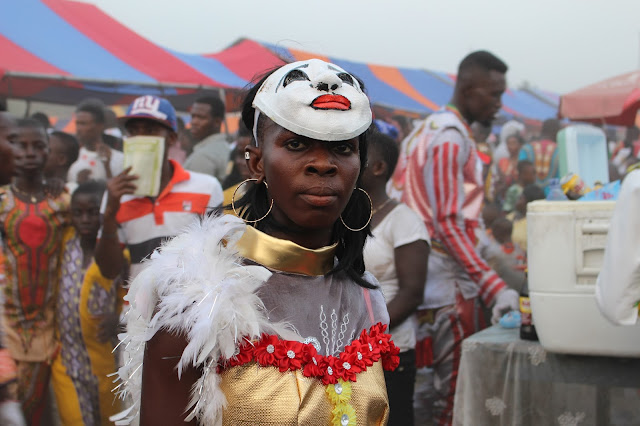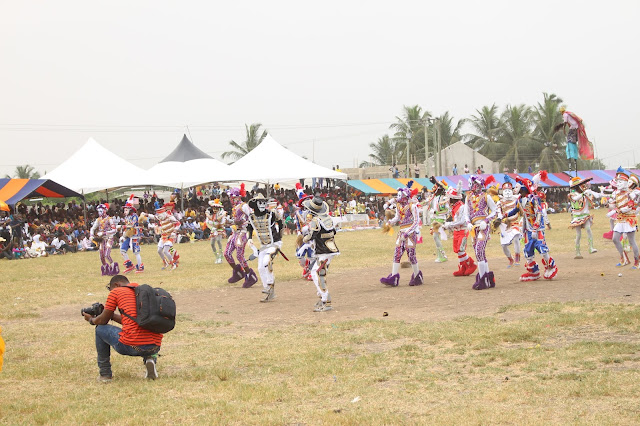SIMPA’S MASQUERADE FESTIVAL; NOTHING LIKE IT!
SIMPA’S MASQUERADE FESTIVAL; NOTHING LIKE IT!
 In
my last article on the brand ‘Winneba’ I promised readers an in-depth expose on
each of the brand attributes of the restful and culturally wealthy town
Winneba. For the purposes of clarity, Simpa is the same town as Winneba. In
simple terms the other/native name of Winneba is Simpa. So the two names would
be used interchangeably in this article. Starting in no order, we begin with the
masquerade which is one of the most spectacular, major and thrilling festivities you
can experience in Ghana.
In
my last article on the brand ‘Winneba’ I promised readers an in-depth expose on
each of the brand attributes of the restful and culturally wealthy town
Winneba. For the purposes of clarity, Simpa is the same town as Winneba. In
simple terms the other/native name of Winneba is Simpa. So the two names would
be used interchangeably in this article. Starting in no order, we begin with the
masquerade which is one of the most spectacular, major and thrilling festivities you
can experience in Ghana.
‘Kaakaamotobi’
and Fancy/Fanti Dress are very familiar terms you might have heard. These are
local and coined terms for what is technically known as the Masquerade. Various towns and cities that are associated
with it are mostly found along the coastal belt and the central parts of Ghana,
mention can be made of Saltpond, Swedru, Takoradi and Winneba .
I
have experienced several masquerade festivals throughout the country, indeed
each town or city’s masquerade festival has been greatly influenced by their
own cultural elements. However without bias or prejudice, I can advance to a
greater extent that the Winneba Masquerade is a ‘Primus inter Paris.’ Importantly, we will come to the know briefly
about the emergence of the festival, changes that has occurred to it, the
fashion associated with it, the pomp and pageantry involved and why you must
make a date to see this colourful, exciting and eye-catching event.
Emergence of the Festival
According
to documentary and oral tradition sources, the idea to form the masquerade group was ignited in the early 20th century. Historical records
indicate that early European settlers notably the Dutch and British Merchants celebrated
Christmas by wearing fanciful masks and costumes during their drink ups and
parties especially at White -owned bars. in the case of Winneba's masquerade, It is documented that an indigene of
Saltpond called Egyanka (Janka) Abraham then a worker at the Winneba Seaport
realised the possibility of localising this practice, he somehow had close
links to these white merchants. Egyanka (Janka) Abraham then organised some of
his friends and communicated his intentions to them. It has been said that some
of the founding and early members of the first masquerade group called the A Max which latter become known as the Nobles
Number 1 group around the early 1920’s included; A. K Yamoah, Kweku Ben, Mr.
Tawiah, Papa Kow Bosomtwe, Papa Kofi Ketu, Papa Otu, Papa Odobi , Papa Painstil
among others. Furthermore the period between 1924 -1933 saw the formation of
three other groups who emanated successively probably from the first group. The
groups in order of age include; Nobles (Number 1), Egyaa (Number 2), Tumus
(Number 3) and the Red Cross (Number 4). Traditionally till today, the number of Masquerade
groups in Winneba is four (4).
Evolution of the Masquerade
It
has been suggested that the earliest masquerade groups paraded the streets of Simpa
during the Christmas seasons .They did this with accompaniment such as the
‘adaha’ band; sideways flute and a special mpetsiba – which is moulded in a
form of a hollow oval metal with a ring worn on the thumb finger that hits the
top of the oval to beat time for the drummers. History has it that the masquerade was so interesting and mysterious and this made children fear them due to the fact that no one saw how their costumes, masks, hats and boots(deepose) were made. In fact no one sees a tailor making a dress for the masquerades during the earliest days! Importantly, the masquerades never revealed their faces and those who dressed as Cow Boys were very much feared and they were considered ruthless! I grew up to experience how these so called 'Cow Boys' would give you some strokes of their cane if you stood in their way.
 |
| Modern Day Cow Boys without their masks (2016) |
The Brass Fusion
Historical
records indicate that a member of the Nobles group, Papa Kweku Atta Yamoah (AK
Yamoah) a merchant conceived the idea of introducing brass band music with the parading. Various oral tradition accounts all agree that the Red Cross group which was formed by AK Yamoah and the
Painstil’s was the first group which incorporated brass music into the
masquerade. This attracted more attention, audience and style. Realising the
opportunity this had created, the other groups emulated the Red Cross group.
 |
| The Nobles Number 1 Brass Band |
Inclusion of Women
Another
distinguishing feature about this festival is the inclusion of women and children. Initially
women who were part of these groups provided food and other support services to
the members of the brass band and the masquerade group as a whole. However
changes in socio-cultural structures have seen women and children fully participating in
this festival not as cooks anymore but as part of the larger masquerade groups.
 |
| A picture of some masquerades in the early 1970's including a lady (cook) |
 |
| A lady Masquerade (2016) |
|
The
dynamism in culture and society has had much influence on every facet of the
masquerade festival today. The fashion trends, the fanciful masks, the rich
brass music and the intense dancing moves have all undergone major changes
which has shaped the festival into what it is today.
The
Winneba masquerade festival is so much rich and different from the others in so
many ways. If you have been a witness
before, you would simply acknowledge that ‘Winnebarians invest a great deal of
money, time, energy and skill in the making of the festival’. A lot of money
goes into the making of the dresses/costumes, mask acquisition, the band and
even the maintenance of the group.
 |
| A section of a Masquerade group exhibiting their skills (2016) |
The Uniqueness of the Festival
Striking
features of the Winneba masquerade includes its characteristic and well-structured
competition. Mostly on the 1st of January each year, the four groups
all compete for the 1st position –a prestige each one craves for at
the South Campus (Advance) Park .The judges award marks by starting an
inspection of the parade to determine the group that is well dressed and
represented. This is then followed by a March pass by all the groups. The dance
competition starts with the blues which is mostly referred to as the slow
dance, the highlife and the Atwum (fast dance) then follows each section
respectively. Each of the groups participate in these sections exhibiting their
beautifully designed costumes, well moulded hats, and unbeatable dancing skills
accompanied with the buzzing sound of horns and the rumbling sound of bass and snare drums.
 | |
| A section of a group doing some slow dance moves |
Personally
I have heard visitors and even indigenes relish the scenes in this hilarious
and fun filled festival. To some memories of the various colourful costumes has
imprinted a mark in their memories, others cannot forget the well-rehearsed and
arranged dance moves. To some spectators the blazing and buzzing sound of the
brass band lingers on their memory while others too cannot comprehend the dangerous
but amazing display of the men on the stilt. It is amazing how these young guys
often walk on 6 to 12 feet stilts and manage to still feel comfortable and put
up various moves and skills. I have always remarked that the ‘Simpa fancy dress
has its strength in the euphoria, enthusiasm, energy and the passion that is
exhibited by both the indigenes and participating individuals and I think this is
what creates the uniqueness.’
 | |||||||||||||
| A man doing some moves on a stilt (2016) |
Quite
apart from serving as a source of entertainment. The festival creates benefits
for all stakeholders. Thus the masquerade provides a win-win situation for both participates
and spectators whether visitors or Winnebarians.
The
festival offers an amazing opportunity for the preservation of culture
especially in the areas of music and dance. This then provides the basics for
academic research and studies. You are welcome to study and research on this
beautiful festival while at the same time getting entertained to good music,
colourful costumes and gesture-filled dance moves.
Additionally
the festival brings in revenue and engagement for the youth, I personally
believe that structural improvement in the sponsorship of this event will go a
long way to generate much revenue for the Winneba Township as a whole. In
relation to this it is my strong conviction that the festival needs much more
attention than what it is enjoying now. It should definitely soar to higher heights
because of its spicy nature, it wouldn’t be a bad idea if groups are called
upon both at home and internationally to perform as in the days of old.
Make
a date for the Festival.
This
article might have gotten you in the mood to witness this spectacular festival.
However don’t just rely on this article, pictures or videos as your experience
of this festival. Believe me you would have a totally different memory and story of your
own to tell family and friends after witnessing this festival! So make a date with Winneba
on the 1st of January every year, book your hotel and airplane/bus
ticket and come have fun whiles learning!
Compiled by;
Richard Abakah-Akumah (MC Afedzi)
Professional MC /Research Assistant
Online Marketer/Digital Marker/ Singer/Songwritter
+233262155356/ +233209798199
ibrandafrika@gmail.com
Follow us on Facebook; ibrandafrica and on Instagram; ibrandafrika



Great article
ReplyDeleteRemarkable as always!! Keep them streaming
ReplyDeleteGreat
ReplyDeleteCan't wait to be there this Christmas season.
ReplyDeleteI've to cone and experience some of this culture in my own country.
Good dues to the originated groups.